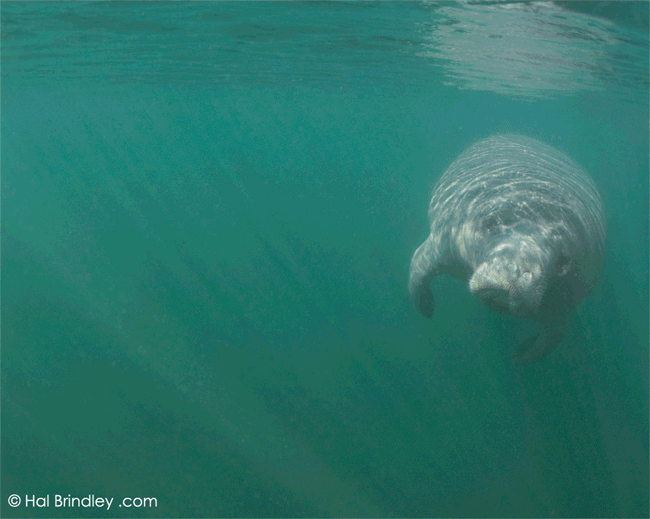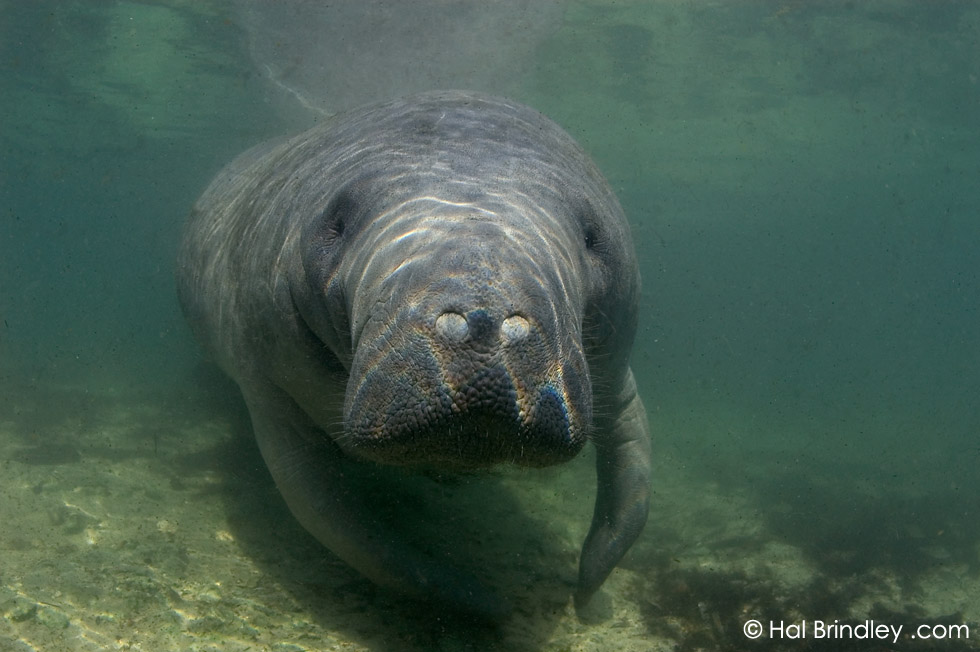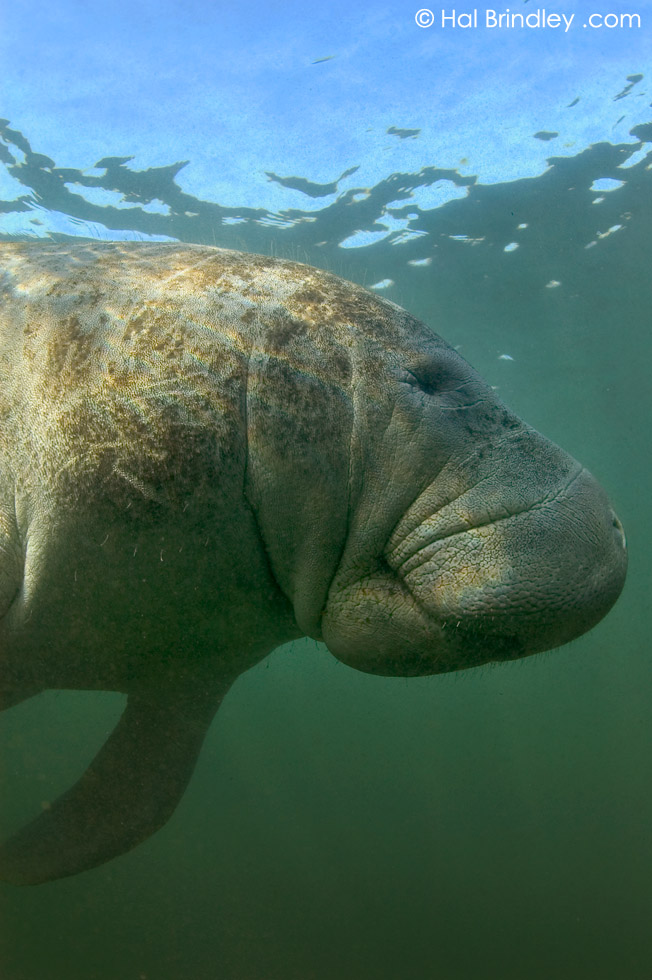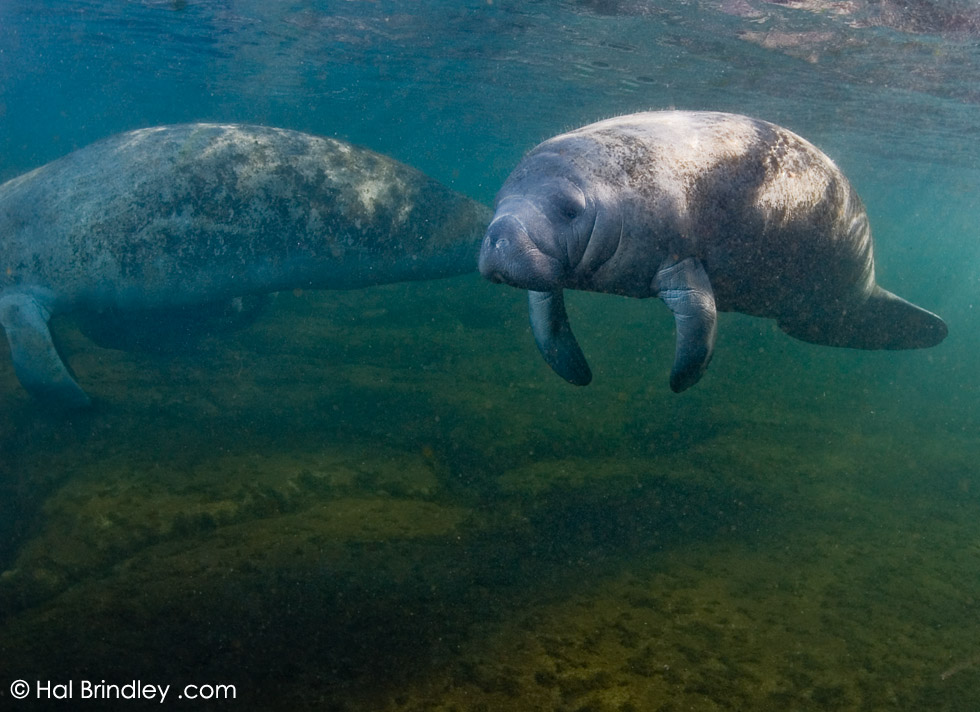There is a 1,500 pound wild animal moving toward you out of the murk. It moves forward with a slow, self-assured, deliberate grace. You stare dumbfounded, a flash of primeval panic runs through you as the beast makes its final approach. You’ve come to swim with manatees in Crystal River, Florida
Just before your inevitable doom, the creature makes an unexpected maneuver and it becomes perfectly clear what this behemoth has planned.
It rolls over onto its back and comes to a stop directly in front of you.
It wants to have its belly scratched.
It was two days after Christmas. I awoke in the spare bedroom at my mom’s house in the mountainous end of South Carolina and snuck a Christmas cookie from the tin on the dresser. While packing my bags to go home I glanced out of the window at the sub-freezing morning and wished that home wasn’t northward. I lugged my bags out to the car and as I scraped the ice from my windows, a strange thought flitted through my head. Less than a thought. A word really.
Mermaids.
This seemed somewhat inappropriate on a frosty winter morning until I realized what I was staring at through the hole in the ice. A mesh bag inside my car containing a mask, flippers and snorkel, Christmas presents to myself, along with an underwater housing for my camera. I wanted to become an underwater photographer. I’ve always been one to follow my dreams and my dream was to swim with the mermaids, or rather the real-life inspiration for that myth. The magical creature known as the manatee.
Having performed a successful trial in the bathtub just the day before, I was itching to get this housing into open water. From the front, the heavy bronze-colored contraption looks like a fish bowl. From the back it appears to be a high-tech torture device with buttons and knobs protruding in all directions, and fighter plane machine-gunner grips sticking out of the sides. Inside, my camera rests snug and dry and slightly nervous.
It suddenly seemed that the old adage “there’s no time like the present” actually applied to me. I marched inside to inform my mom, “Change of plans, I’m going to Florida to swim with manatees.” Mom said “Cool! Have fun. Let me make you some turkey sandwiches for the road.” I grabbed my bundle, the mandatory package of food that mothers insist on giving their children as they head out the door, and I was on my way.
Want to visit the manatees? Why not Rent A Private Island near Crystal River? Be sure to check out this list of Florida Private Island Rentals that includes an island in Cedar Key and one in Homosassa, both close to Crystal River!
(The individual in this photo bears the nasty scars of a recent propeller encounter, as do most manatees. Boat collisions are probably the leading cause of death among these gentle, slow-moving giants.)
I knew it would be worth the drive, but nothing could prepare me for the amazing encounter I was about to experience.
It seems to me that the encounter must be just as interesting from the manatee’s point of view. Here’s how I imagine a manatee might write about their yearly encounter with the humans of Crystal River:
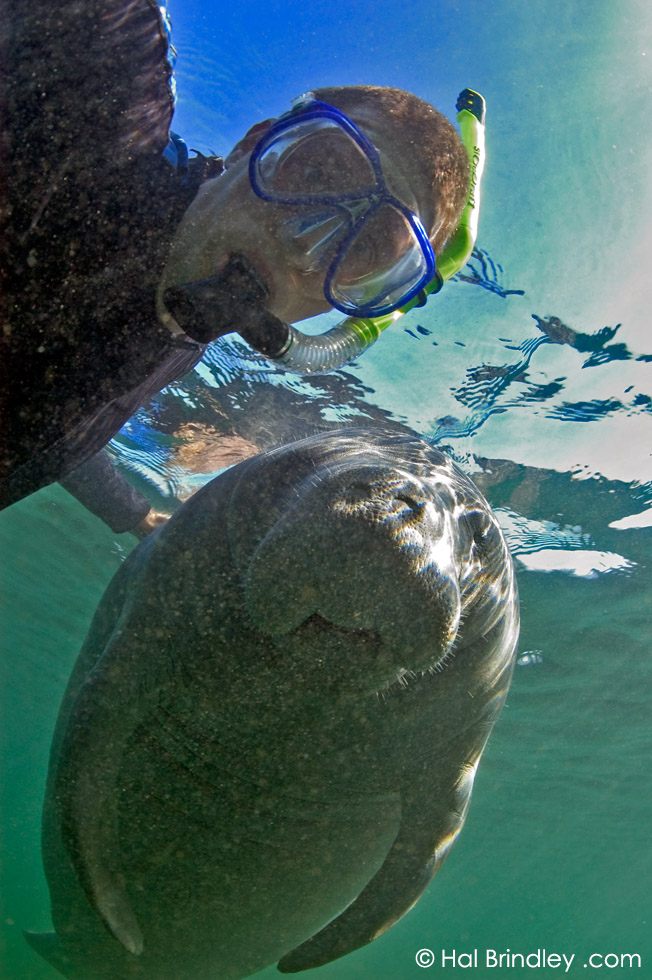
I swam toward the bizarre creature. It reached out with its strange limb and touched me. It’s stroking my back! Hee-hee, that feels kinda good. I roll over onto my back and let it scratch my belly. It’s a little weird but rather pleasant. Then I hear a youngster squeaking, “Can I mom, can I please go over there?”
“Oh I don’t know” she replies in a worried tone. “You know you don’t see very well.”
“Mom! None of us can see very well! We have eyes like tiny butt-holes!” The child swims impetuously across the line and cavorts with the alien creature, rubbing against it and twirling around it, then darts back to her mother’s side. The beast has a flat reflective face and appears to have two long thin tails. It holds a most unusual contraption, like a big bubble. I put my face up to it for a closer look and it clicks. As my whiskers tickle its surface I think to myself how much I love coming back to Crystal River every year to swim with the humans. Such strange and curious creatures.
I get the feeling that the encounter is just as interesting from the manatee’s point of view as it is from ours.
This is absolutely incredible. It is unlike any animal interaction I have ever experienced anywhere in the world.
Sure there are lots of places where wild animals will approach humans and even permit contact but there is one very important difference here.These animals are not being fed.
They have no incentive to hang out with humans. The manatees have protected areas where they can roam free from human disturbance. And yet they choose to swim amongst the throngs of visitors.
Why? Because they are curious and playful and seem to truly enjoy the contact. They are like massive, blobular puppy dogs.
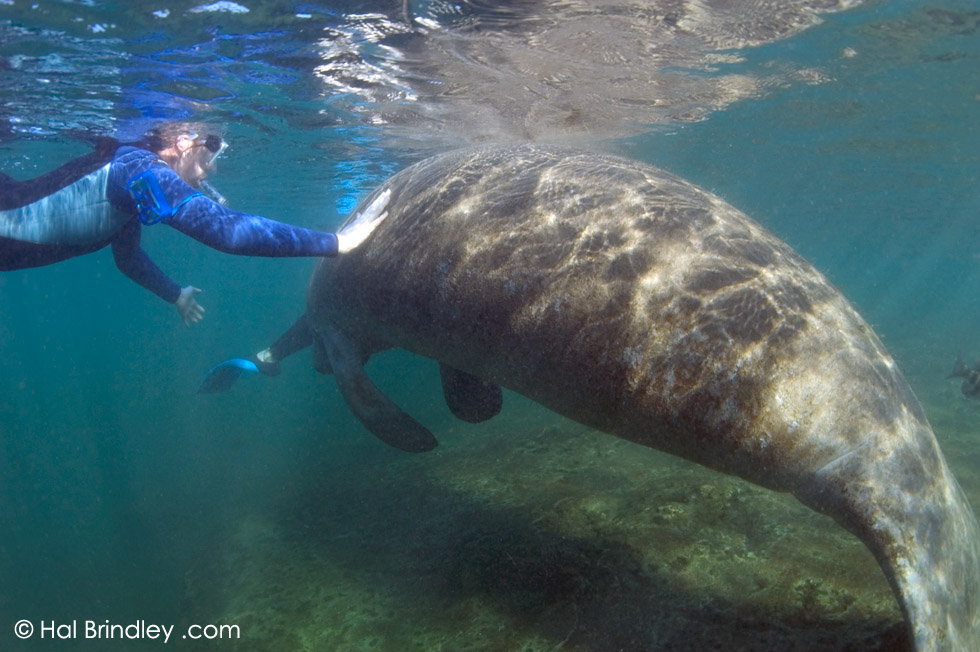
Never once as a wildlife photographer have I had to physically hold my subject away from me with one hand while I attempted to take a photo of it with the other. It just isn’t a common problem with wild animals.
When one first approached me face to face, I found myself back-pedaling in a state of giggly nervousness. But I soon got used to the idea of cuddling with a thirteen-feet-long lard torpedo.
I had one youngster who stuck so close to me that I couldn’t keep track of where it was. I was laughing so hard into my snorkel that I couldn’t have held the camera still anyway. It was pure magic.
I was completely hooked from that point on. I knew I would come back here every chance I could for the rest of my life. And do my part to help save these amazing animals from extinction. (for example: the boat in this photo has a manatee protection guard under the propeller. If you boat in Florida, be sure you have one.)
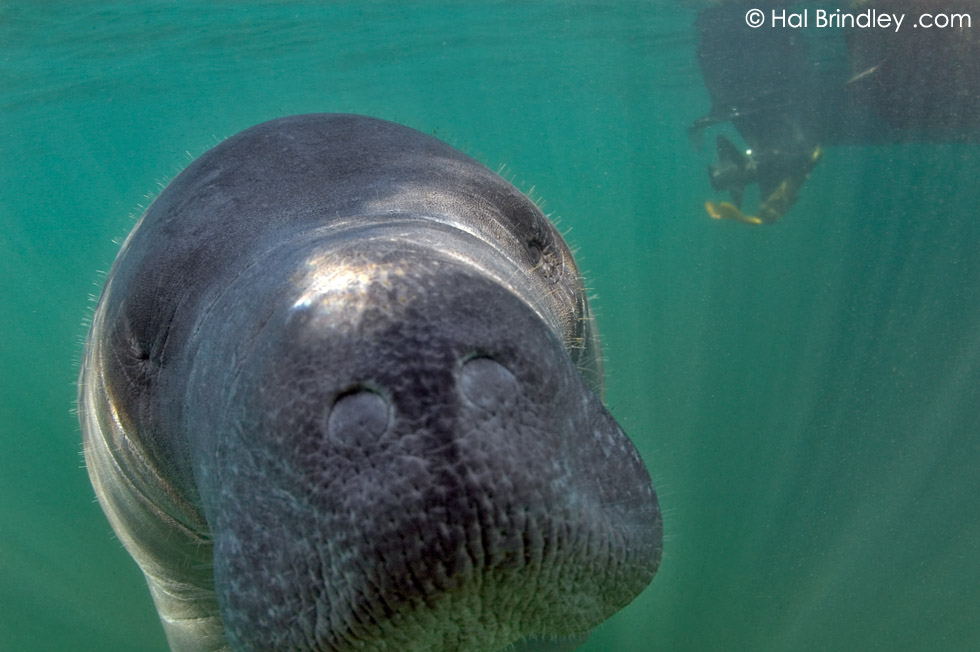
There were about 50 people snorkeling in the general area of King Spring, transported by more than a dozen manatee-tour pontoon boats anchored nearby.
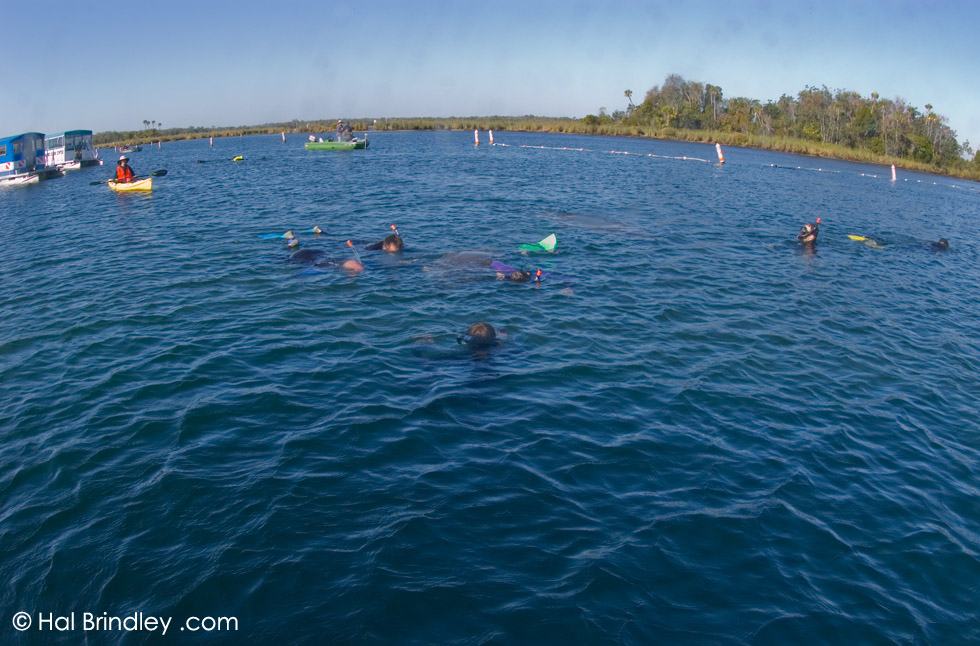
The spring erupts from a deep underwater cave and pumps 72 degree water into the Crystal River year-round. This is the reason the manatees come back every winter. Six hundred million gallons of fresh water are produced each day by thirty or more natural springs in the area.
The Chassahowitzka National Wildlife Refuge Complex provides critical winter habitat for roughly 25 percent of the manatee population in the Gulf of Mexico. During the summer manatees disperse into the open ocean. But from December to March of every winter, when the ocean waters get too cold for comfort, you will find them concentrated around warm water sources like Crystal River or the warm-water discharge from power plants.
When we first parked our tour boat, this manatee swam up and began playing with and chewing on our anchor line. How cute is that?
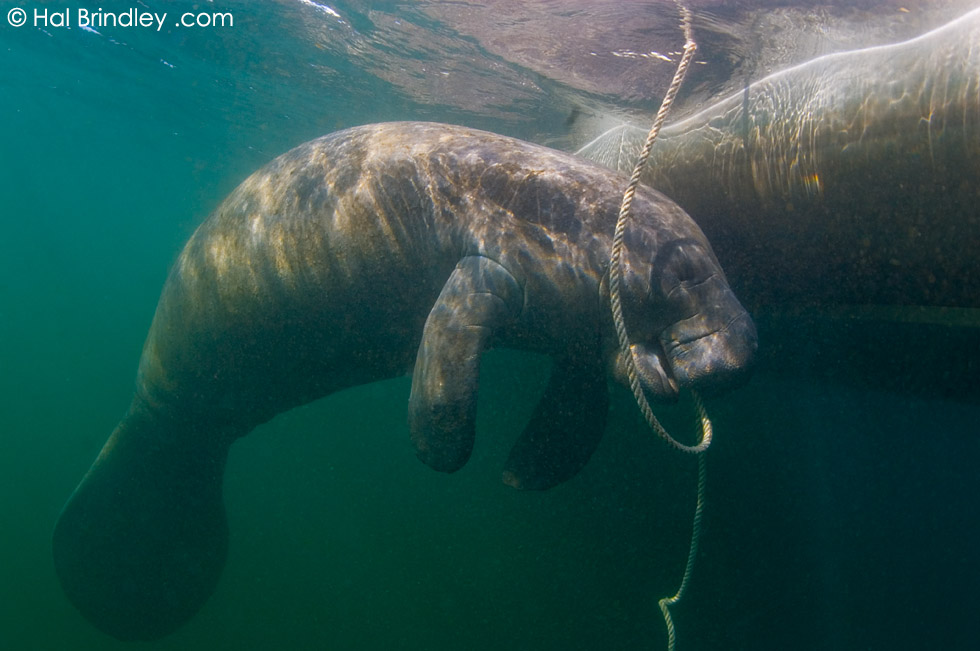
Manatees are mammals like you and me. That means they have to breathe air even though they spend their entire lives underwater.
Here one is taking a breath from the surface through its nostrils. This is usually all you see of a manatee from the surface. It looks like a gray baked potato has floated up from the depths, when suddenly it explodes with a burst of hot air.
Manatees are vegetarians and consume 60 to 100 pounds of aquatic vegetation each day. They sit on the bottom and graze like huge underwater cows. They can stay submerged for up to 16 minutes but when they are sleeping they will rise to the surface every few minutes. Imagine trying to sleep while holding your breath.
The West Indian Manatee (its full name) is an endangered species and is protected by federal and state law. The Florida Manatee Sanctuary Act states:
“It is unlawful for any person, at any time, by any means, intentionally or negligently, to annoy, molest, harass, or disturb any manatee” Harassment is defined as any activity which alters the animal’s natural behavioral characteristics.

• Do not approach a manatee before the animal first approaches you
• Do not actively pursue/chase (swim after) or corner a manatee while swimming or diving
• Do not poke, prod, or stab a manatee at any time with any object, including but not limited to a person’s hands or feet.
• Do not separate a cow from her calf or an individual from a group
• Do not attempt to snag, hook, hold, grab, pinch, or ride a manatee
• Do not feed a manatee Do not touch or disturb a resting manatee
These rules are important because manatees are just so darn friendly (as shown by this photo of a manatee investigating a kayaker)
It is estimated that there are only about 3,000 manatees left in U.S. waters. These incredible animals have been around for 60 million years, much longer than we have existed and yet, due to our negligence and our greedy consumption of their habitat (Florida coastal property) they are on the brink of extinction.
It was such an amazing honor and privilege to be nuzzled by an individual from a dying breed. But they don’t know that. They are the same trusting, gentle and lovable creatures they’ve always been. The mermaids of the Caribbean.

To find out what you can do to help the Florida manatee visit SaveTheManatee.org. For more info about the Crystal River NWR visit fws.gov/crystalriver
* Follow up notes: 2014: Now, after having visited the manatees many times, I choose to not actively touch the manatees any more. Not only does it start looking pretty invasive after a while, but it also gives manatees an incentive to approach humans in the wild (because they enjoy having their belly scratched), which will inevitably lead to more boat collisions and deaths. So my advice is, after you’ve petted your first manatee, respectfully keep your hands to yourself and let the manatees approach you!
You can read more of our manatee posts on Travel For Wildlife:
How To Swim With Manatees in Crystal River, Florida
Where to See Manatees in the Wild
